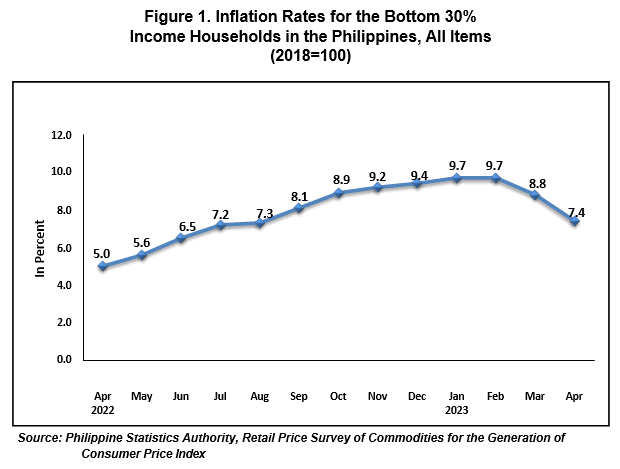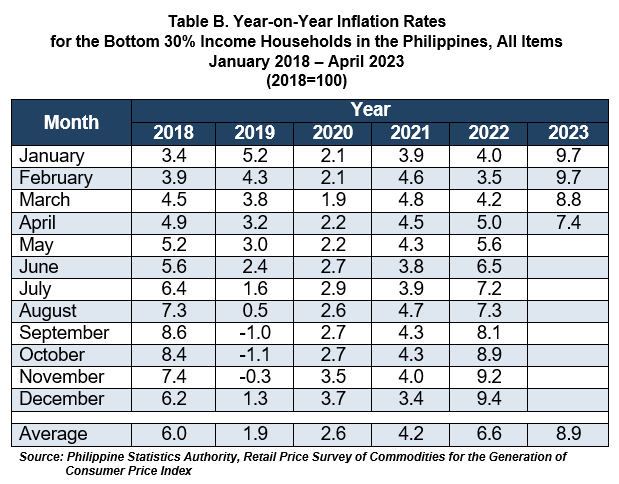Table A. Year-on-Year Inflation Rates
for the Bottom 30% Income Households, All Items
In Percent
(2018=100)
|
|
|
|
|
|---|---|---|---|---|
| Philippines | 5.0 | 8.8 | 7.4 | 8.9 |
| NCR | 4.0 | 8.7 | 8.0 | 9.0 |
| AONCR | 5.0 | 8.8 | 7.4 | 8.9 |
| Source: Philippine Statistics Authority, Retail Price Survey of Commodities for the Generation of Consumer Price Index *Year-on-year change of average CPI for January to April 2022 vs. 2023 | ||||

A. Philippines
1. Overall Inflation
The overall inflation for the bottom 30% income households in the country slowed down further in April 2023 to 7.4 percent from 8.8 percent in March 2023. In the same month of the previous year, inflation rate was lower at 5.0 percent. The annual average inflation rate for the first four months of 2023 stood at 8.9 percent. (Figure 1, and Tables A, B, 5, 6, 12)
1.1 Main Drivers to the Downward Trend of the Overall Inflation
The downtrend of the overall inflation for the bottom 30% income households was primarily driven by the lower inflation rate of the heavily- weighted food and non-alcoholic beverages, which decreased to 7.8 percent during the month from 9.5 percent in March 2023. This was followed by housing, water, electricity, gas and other fuels, which posted an annual mark-up of 7.7 percent in April 2023 from 9.5 percent in the previous month. The third main driver to the downtrend was transport with an annual growth rate of 4.0 percent in April 2023 from 6.1 percent in the previous month.
In addition, the annual growth rate of information and communication index was slower during the month at 0.8 percent from 0.9 percent in the previous month.
On the contrary, higher annual upticks were observed in the indices of the following commodity groups during the month:
a. Clothing and footwear, 5.5 percent from 5.3 percent;
b. Furnishings, household equipment and routine household maintenance, 6.3 percent from 6.2 percent; and
c. Recreation, sport and culture, 5.8 percent from 5.5 percent.
The indices of the rest of the commodity groups continued to move at their respective previous month’s rates. (Tables 5 and 6)
1.2 Main Contributor to the Overall Inflation
The following commodity groups were the primary contributors to the overall inflation for this income group during the month:
a. Food and non-alcoholic beverages, 58.1 percent share or 4.3 percentage points;
b. Housing, water, electricity, gas and other fuels, 16.2 percent share or 1.2 percentage points; and
c. Restaurants and accommodation services, 8.3 percent share and 0.6 percentage points.
2. Food Inflation
Following the trend of the overall inflation for the bottom 30% income households, food inflation for this income group, likewise, decelerated to 7.8 percent in April 2023 from 9.7 percent in the previous month. The average food inflation for the first four months of the year stood at 9.6 percent. In April of the previous year, food inflation was recorded at 4.3 percent. (Table 9)
2.1 Main Drivers to the Downward Trend of the Food Inflation
The downtrend in the food inflation is primarily attributed to the lower annual increments observed in fish and other seafood at 7.4 percent during the month from 12.3 percent in the previous month. Also contributing to the downtrend is the lower inflation of vegetables, tubers, plantains, cooking bananas and pulses at 11.4 percent in April 2023 from 20.2 percent in March 2023.
In addition, lower annual increments were observed in the indices of the following food groups during the period:
a. Corn, 7.9 percent from 11.8 percent;
b. Flour, bread and other bakery products, pasta products, and other cereals, 10.8 percent from 10.9 percent;
c. Meat and other parts of slaughtered land animals, 4.7 percent from 5.4 percent;
d. Milk, other dairy products and eggs, 12.3 percent from 12.8 percent;
e. Oils and fats, 10.9 percent from 14.3 percent;
f. Sugar, confectionery and desserts, 40.4 percent from 42.2 percent; and
g. Ready-made food and other food products not elsewhere classified, 7.9 percent from 8.5 percent.
On the other hand, higher annual increments were noted in April 2023 in the indices of rice at 3.0 percent from 2.6 percent, and fruits and nuts at 10.8 percent from 9.5 percent. (Tables 7 and 11)
2.2 Main Contributors to the Food Inflation
The food inflation contributed 54.5 percent or 4.0 percentage points to the overall inflation for the bottom 30% income household in April 2023.
Of the 7.8 percent inflation for food during the month, the top contributors were cereals and cereal products, which includes rice, corn, flour, bread and other bakery products, at 29.9 percent share or 2.3 percentage points; fish and other seafood with 15.9 percent share or 1.2 percentage points; and sugar, confectionery and desserts with 14.4 percent share or 1.1 percentage points.

B. National Capital Region (NCR)
Inflation for the bottom 30% income households in NCR continued its downtrend at 8.0 percent in April 2023 from 8.7 percent in March 2023. In the same month of the previous year, inflation for this income group was posted at 4.0 percent. (Tables A, 5, 6, and 13)
The deceleration in the NCR inflation was primarily driven by the lower annual growth in the index of food and non-alcoholic beverages at 8.1 percent in April 2023 from 9.0 percent in the previous month. Housing, water, electricity, gas and other fuels also contributed to the downtrend with slower annual increase of 6.7 percent during the month from 8.1 percent in the previous month.
In addition, lower annual increments were observed in the indices of the following commodity groups during the month:
a. Alcoholic beverages and tobacco, 8.9 percent from 9.0 percent;
b. Transport, 14.3 percent from 14.7 percent; and
c. Information and communication, 0.4 percent from 0.5 percent.
In contrast, the indices of the following commodity groups exhibited higher annual growth rates during the month:
a. Furnishings, household equipment and routine household maintenance, 5.0 percent from 4.7 percent;
b. Recreation, sport and culture, 3.8 percent from 3.7 percent;
c. Restaurants and accommodation services, 11.4 percent from 11.0 percent; and
d. Personal care, and miscellaneous goods and services, 3.6 percent from 3.5 percent.
The index of health continued to show an annual decline of -0.6 percent during the month from -0.7 percent in March 2023. The indices of the rest of the commodity groups retained their previous month’s annual rates. (Tables 5 and 6)
C. Areas Outside NCR (AONCR)
The inflation for this group of consumers in AONCR eased further to 7.4 percent from its previous month's rate of 8.8 percent. In the same month of the previous year, inflation in AONCR for this income group was recorded at 5.0 percent. (Tables A, 5, and 14)
The slowdown in inflation was mainly attributed by the lower year-on-year growth rate of the index of food and non-alcoholic beverages, which posted an annual rate of 7.7 percent in April 2023 from 9.5 percent in the previous month. Also contributing to the downtrend is the lower annual increase in the index of housing, water, electricity, gas and other fuels at 7.8 percent during the month from 9.6 percent.
Moreover, lower annual increments were registered in the indices of the following commodity groups during the month:
a. Transport, 3.6 percent from 5.8 percent;
b. Information and communication, 0.8 percent from 0.9 percent; and
c. Personal care, and miscellaneous goods and services, 6.2 percent from 6.3 percent.
On the other hand, higher annual mark-ups were recorded in the indices of the following commodity groups during the period:
a. Clothing and footwear, 5.6 percent from 5.4 percent;
b. Furnishings, household equipment and routine household maintenance, 6.4 percent from 6.3 percent; and
c. Recreation, sport and culture, 5.9 percent from 5.6 percent.
The indices of the rest of the commodity groups remained at their respective previous month’s annual rates. (Tables 5 and 6)
All regions in AONCR exhibited lower inflation rates for the bottom 30% income households in April 2023 compared with their respective inflation rates in the previous month. Among the regions outside NCR, Region VIII (Eastern Visayas) posted the lowest inflation rate during the month at 6.0 percent, while MIMAROPA and Region XI (Davao Region) both registered the highest inflation rate of 9.0 percent. (Table 6)
Note: CPIs and inflation rates for the bottom 30% income households by region are posted at the PSA OpenSTAT Portal at (http://openstat.psa.gov.ph/).
DENNIS S. MAPA, Ph.D.
Undersecretary
National Statistician and Civil Registrar General
See more at the Consumer Price Index for Bottom 30% Income Households main page.
